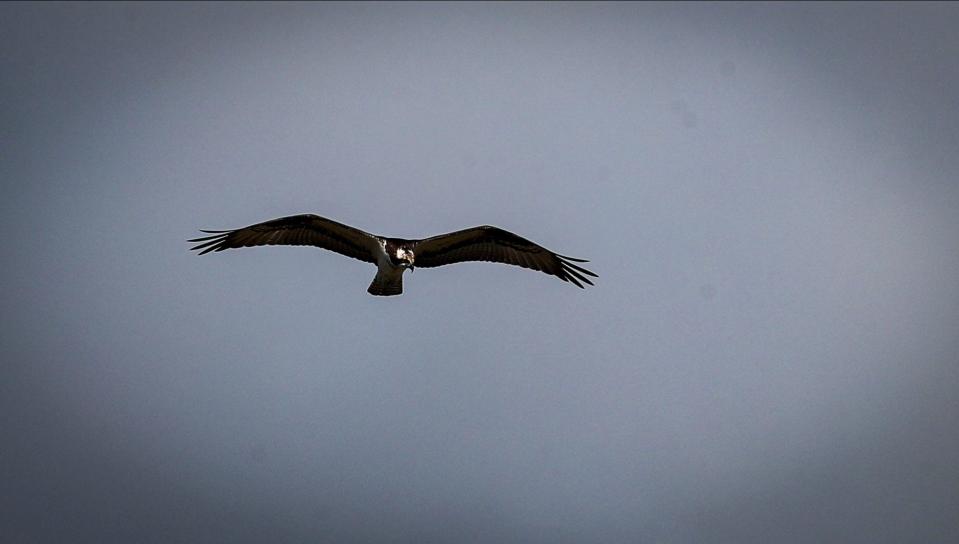Millions of birds aren't feeding on Florida's largest lake. What is going wrong?
Lake Okeechobee was consistently high in 2023, and the liquid heart of the Everglades is so high now that it's inhibiting growth of the aquatic plants that form the basis of the world-class largemouth bass fishery.
Although parts of Florida suffered through drought conditions last year, the lake hovered around 16 feet above sea level.
The worry now is that high lake levels are further crippling plants in the lake, and more El Nino rains could mean releases to the Caloosahatchee River. The high water levels also affect other wildlife.
"It's got some really big problems right now because when the lake gets this deep basically the submerged aquatic plant zone, it is virtually gone," said Paul Gray, a water quality scientist for Audubon of Florida. "We'd like to have 40,000 or 50,000 acres but maybe there's 1,000 or 2,000 acres. And those are like the sea grasses and so that's where the bass fishery spawns and that's where the crappie fishery spawns."
The U.S. Army Corps of Engineers has since 2008 worked to keep lake levels between 12.5 and 15.5 feet above sea level to provide flood control and water supply to farms and urban areas.

But with the Herbert Hoover Dike being reinforced and beefed up over the past decade, the Army Corps has let the has let the lake go above that 15.5 feet threshold; and future management protocols will allow the lake to get 17 feet or higher.
Storing more water in the lake means fewer damaging discharges to the Caloosahatchee and St. Lucie rivers, two outlets that were artificially connected to the lake to help drain the Everglades for farming and development.
New lake schedule should be adopted soon
The new schedule, called the Lake Okeechobee System Operations Manual, or LOSOM, is expected to be adopted and in place later this year, Corps officials have said.
Gray said the lake is too deep to support the millions of shorebirds and wading birds that typically feed on the lake during the winter and spring.
More: Reporter finds flamingo haven on recent 11-day Everglades canoe trip
"Everything inside the dike is at least a foot deep, and they have to have water that's 1- to 2-inches deep," Gray said. "The dabbling ducks and ibises and snowy egrets needs the water 6 inches or shallower, so to not have that valuable resource is pretty frustrating."
Gray said the lake will likely suffer even more in the future, as the Army Corps switches from the Lake Okeechobee Regulation Schedule, or LORS (2008), to LOSOM.
"It's really unfortunate to watch the lake go downhill and not able to host the amount of wildlife we can support," Gray said. "And if we're this bad after LORS, they're going to make the lake even deeper under LOSOM."
The surface of the lake was at 16.3 feet above sea level Wednesday, according to South Florida Water Management District records.
Lake releases could be a reality
If the lake gets too much higher, the Army Corps will be forced to make releases, largely to the Caloosahatchee River.
"If it gets above 16-and-a-half feet, one big rainstorm and we're all going to be sharing the adversity," Gray said.
Calusa Waterkeeper Codty Pierce said he's concerned that releases to the Caloosahatchee River could be in store, especially with El Nino conditions impacting weather here.
"In the past couple of weeks (the W.P. Franklin Lock and Dam) has been in the stress flow range to the estuary just because we've had sporadic rain across the state," Pierce said. "With El Nino, there is some unpredictability with that."
The dam is the structures that divides the freshwater upper portions of the river from the estuary.
More: Lessons learned: Reporter recalls 12-day canoe trip through Everglades National Park
El Nino has caused heavy rains across much of the state this winter, with some areas reporting 6 or more inches in the course of 24 hours.
Pierce said the scenario is always the same ― that the river is in danger of receiving too much or too little water.
"I feel like we play the same fiddle all the time," Pierce said. "We are very vulnerable from rainfall and discharges. It’s the same tune."
Gray said he doesn't think the lake will drop more than 2 feet between now and mid-May, the beginning of the next rainy season.
"I don't think it's likely to drop much below 14 feet and ideally we'd draw down to 12, but to get the lake that far down we'd have to have severe water discharges," Gray said. "There's just harm in the system and there's no way to get rid of it."
Connect with this reporter: Chad Gillis on Facebook.
This article originally appeared on Fort Myers News-Press: More El Nino rains could lead to lake releases for Caloosahatchee

